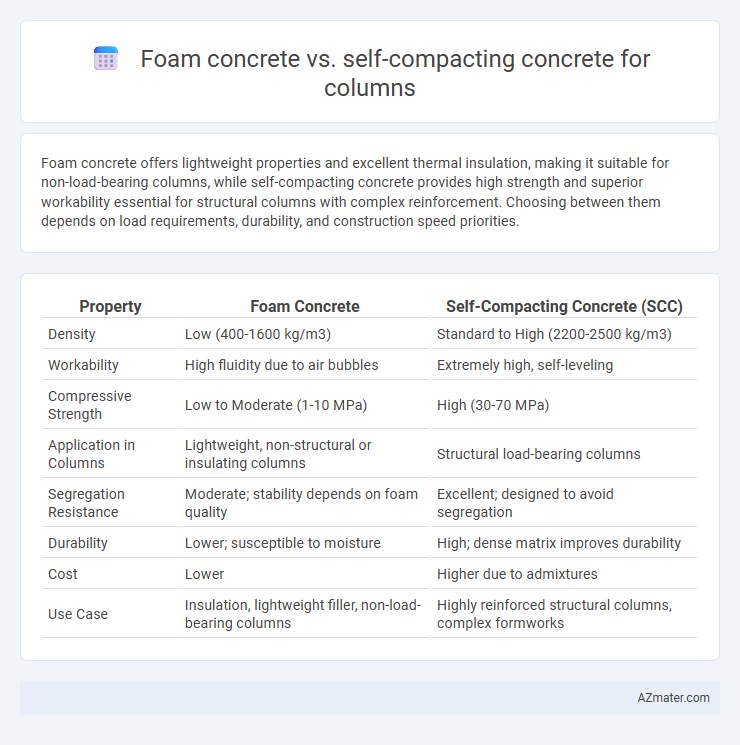Foam concrete offers lightweight properties and excellent thermal insulation, making it suitable for non-load-bearing columns, while self-compacting concrete provides high strength and superior workability essential for structural columns with complex reinforcement. Choosing between them depends on load requirements, durability, and construction speed priorities.
Table of Comparison
| Property | Foam Concrete | Self-Compacting Concrete (SCC) |
|---|---|---|
| Density | Low (400-1600 kg/m3) | Standard to High (2200-2500 kg/m3) |
| Workability | High fluidity due to air bubbles | Extremely high, self-leveling |
| Compressive Strength | Low to Moderate (1-10 MPa) | High (30-70 MPa) |
| Application in Columns | Lightweight, non-structural or insulating columns | Structural load-bearing columns |
| Segregation Resistance | Moderate; stability depends on foam quality | Excellent; designed to avoid segregation |
| Durability | Lower; susceptible to moisture | High; dense matrix improves durability |
| Cost | Lower | Higher due to admixtures |
| Use Case | Insulation, lightweight filler, non-load-bearing columns | Highly reinforced structural columns, complex formworks |
Introduction to Foam Concrete and Self-Compacting Concrete
Foam concrete is a lightweight, aerated material composed of cement, water, and foam, offering excellent thermal insulation and reduced dead load in column construction. Self-compacting concrete (SCC) is a highly flowable, non-segregating mixture that fills formwork under its own weight, ensuring superior surface finish and mechanical performance without vibration. Both materials enhance structural efficiency, foam concrete by reducing weight and SCC by improving workability and durability in column applications.
Key Material Properties Compared
Foam concrete exhibits low density ranging from 400 to 1600 kg/m3 and compressive strength between 1 to 8 MPa, ideal for lightweight, non-structural columns with high thermal insulation. Self-compacting concrete (SCC) possesses higher density of about 2300 kg/m3 and compressive strengths typically between 30 to 70 MPa, ensuring superior flowability and structural performance without segregation. SCC's high viscosity and filling ability make it suitable for heavily reinforced columns requiring uniform compaction, while foam concrete is preferred for non-load-bearing or insulating column applications.
Composition and Mix Design Differences
Foam concrete and self-compacting concrete (SCC) exhibit distinct composition and mix design differences suited for column applications. Foam concrete incorporates a cementitious slurry combined with pre-formed foam that introduces air voids, resulting in a lightweight, highly porous material with densities ranging from 400 to 1600 kg/m3. In contrast, SCC primarily consists of cement, fine aggregates, and chemical admixtures designed to achieve high flowability and segregation resistance without mechanical compaction, maintaining typical concrete densities around 2200 to 2400 kg/m3.
Workability and Placement Methods
Foam concrete offers excellent flowability due to its lightweight, aerated structure, making it easy to place in hard-to-reach column forms with minimal compaction. Self-compacting concrete (SCC) exhibits superior workability by flowing under its own weight, eliminating the need for vibration and ensuring uniform filling and surface finish in complex column molds. Placement methods for foam concrete often involve pumping or pouring with careful control of foam content, whereas SCC relies heavily on its rheological properties to achieve seamless placement and consolidation in reinforced column frameworks.
Strength Characteristics and Load-Bearing Capacity
Foam concrete exhibits lower compressive strength, typically ranging from 3 to 15 MPa, making it suitable for non-load-bearing applications or lightweight infill columns due to its high porosity and reduced density. Self-compacting concrete (SCC) offers superior strength characteristics with compressive strengths often exceeding 40 MPa, ensuring enhanced load-bearing capacity and structural integrity for columns under significant loads. The denser microstructure of SCC contributes to higher durability and better resistance to mechanical stress compared to foam concrete's lightweight, porous nature.
Durability and Longevity in Columns
Foam concrete exhibits lower durability in columns due to its higher porosity, making it more susceptible to moisture ingress and freeze-thaw cycles. Self-compacting concrete (SCC) offers superior longevity with enhanced resistance to cracking and permeability, ensuring structural integrity under harsh environmental conditions. The dense matrix and uniform compaction of SCC significantly improve the durability of columns compared to foam concrete.
Cost Analysis and Economic Considerations
Foam concrete offers significant cost savings in column construction due to its lightweight nature, reducing transportation and handling expenses while lowering formwork and foundation costs. Self-compacting concrete (SCC), although more expensive per cubic meter due to specialized admixtures and higher cement content, minimizes labor costs and accelerates construction timelines by flowing into complex column molds without vibration. Economic considerations favor foam concrete for budget-sensitive projects requiring thermal insulation, whereas SCC delivers value through improved durability and reduced rework in high-precision structural columns.
Environmental Impact and Sustainability
Foam concrete offers significant environmental benefits by using less cement and incorporating air voids, which reduces material consumption and lowers carbon emissions during production. Self-compacting concrete, while facilitating efficient construction and reducing waste due to its high flowability and self-leveling properties, typically relies on standard cement content, resulting in a higher carbon footprint compared to foam concrete. Choosing foam concrete for columns enhances sustainability by minimizing resource usage and promoting energy efficiency in the manufacturing and curing processes.
Typical Applications in Column Construction
Foam concrete is commonly used in column construction for non-structural applications such as infill panels and lightweight partitions due to its excellent thermal insulation and reduced dead load properties. Self-compacting concrete is preferred in structural columns requiring high strength and complex reinforcement arrangements, as it flows easily into tight spaces ensuring uniform compaction without vibration. Typical applications show foam concrete excels in lightweight, non-load-bearing columns, while self-compacting concrete is ideal for load-bearing columns with intricate formworks.
Conclusion: Choosing the Right Concrete for Columns
Foam concrete offers lightweight properties and excellent thermal insulation, making it suitable for non-load-bearing columns where weight reduction is critical. Self-compacting concrete provides superior flowability and high strength, ideal for load-bearing columns with complex reinforcement where quality and durability are priorities. Selecting the right concrete depends on structural requirements, load capacity, and desired performance characteristics of the column.

Infographic: Foam concrete vs Self-compacting concrete for Column
 azmater.com
azmater.com